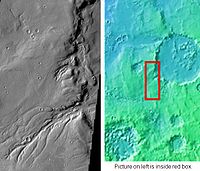Semeykin (crater)
 Semeykin Crater Drainage, as seen by THEMIS. Click on image to see details of beautiful drainage system. | |
| Planet | Mars |
|---|---|
| Coordinates | 41°48′N 351°24′W / 41.8°N 351.4°W / 41.8; -351.4Coordinates: 41°48′N 351°24′W / 41.8°N 351.4°W / 41.8; -351.4 |
| Diameter | 73.51 km |
| Eponym | Boris Semeykin, a Soviet astronomer (1900–1937) |
Semeykin is a crater in the Ismenius Lacus quadrangle on Mars. It is located at 41.8° north latitude and 351.4° west longitude. The crater measures approximately 74 kilometers in diameter and was named after Boris Semeykin, a Soviet astronomer (1900–1937).[1]

MOLA map showing Semeykin Crater and other nearby craters. Colors indicate elevations.

Semeykin Crater, as seen by CTX camera on(Mars Reconnaissance Orbiter).

Wide view of sets of dipping layers in Semeykin, as seen by HiRISE under HiWish program

Close view of dipping layers in Semeykin, as seen by HiRISE under HiWish program
See also
- Impact event
- Ismenius Lacus quadrangle
- List of craters on Mars
- Ore resources on Mars
- Planetary nomenclature
References
^ "Gazetteer of Planetary Nomenclature | Semeykin". usgs.gov. International Astronomical Union. Retrieved 4 March 2015..mw-parser-output cite.citation{font-style:inherit}.mw-parser-output q{quotes:"""""""'""'"}.mw-parser-output code.cs1-code{color:inherit;background:inherit;border:inherit;padding:inherit}.mw-parser-output .cs1-lock-free a{background:url("//upload.wikimedia.org/wikipedia/commons/thumb/6/65/Lock-green.svg/9px-Lock-green.svg.png")no-repeat;background-position:right .1em center}.mw-parser-output .cs1-lock-limited a,.mw-parser-output .cs1-lock-registration a{background:url("//upload.wikimedia.org/wikipedia/commons/thumb/d/d6/Lock-gray-alt-2.svg/9px-Lock-gray-alt-2.svg.png")no-repeat;background-position:right .1em center}.mw-parser-output .cs1-lock-subscription a{background:url("//upload.wikimedia.org/wikipedia/commons/thumb/a/aa/Lock-red-alt-2.svg/9px-Lock-red-alt-2.svg.png")no-repeat;background-position:right .1em center}.mw-parser-output .cs1-subscription,.mw-parser-output .cs1-registration{color:#555}.mw-parser-output .cs1-subscription span,.mw-parser-output .cs1-registration span{border-bottom:1px dotted;cursor:help}.mw-parser-output .cs1-hidden-error{display:none;font-size:100%}.mw-parser-output .cs1-visible-error{font-size:100%}.mw-parser-output .cs1-subscription,.mw-parser-output .cs1-registration,.mw-parser-output .cs1-format{font-size:95%}.mw-parser-output .cs1-kern-left,.mw-parser-output .cs1-kern-wl-left{padding-left:0.2em}.mw-parser-output .cs1-kern-right,.mw-parser-output .cs1-kern-wl-right{padding-right:0.2em}
This article about the planet Mars or its moons is a stub. You can help Wikipedia by expanding it. |
This article about an extraterrestrial geological feature is a stub. You can help Wikipedia by expanding it. |


